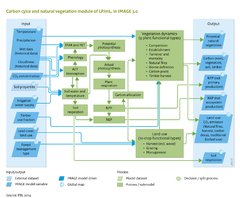Carbon cycle and natural vegetation/Data uncertainties limitations: Difference between revisions
Jump to navigation
Jump to search
Oostenrijr (talk | contribs) m (Text replace - "CO2 " to "CO<sub>2</sub>") |
Oostenrijr (talk | contribs) m (Text replace - "CO<sub>2</sub>" to "CO<sub>2</sub> ") |
||
| Line 8: | Line 8: | ||
Although the terrestrial biosphere plays a key role in the global carbon cycle, it is also subject to considerable uncertainty. Current carbon fluxes are highly uncertain because they cannot be observed directly on a large scale, and vary considerably in time and space. Thus, all available estimates of global carbon pools and fluxes are model-based. | Although the terrestrial biosphere plays a key role in the global carbon cycle, it is also subject to considerable uncertainty. Current carbon fluxes are highly uncertain because they cannot be observed directly on a large scale, and vary considerably in time and space. Thus, all available estimates of global carbon pools and fluxes are model-based. | ||
For the future dynamics of the terrestrial carbon cycle, additional uncertainty arises from physiological and ecological processes and interactions, which change rapidly under changing environmental conditions. As a dynamic global vegetation model, LPJmL can simulate carbon dynamics under internally computed vegetation shifts that occur in response to climate change, the impacts of land-use change, water availability and CO<sub>2</sub>fertilisation ([[Heyder et al., 2011]]). The most uncertain parameters in future dynamics are the combined effect of temperature and precipitation change on soil respiration, and the effect of CO<sub>2</sub>fertilisation. An uncertainty range for how the terrestrial biosphere may react to climate change scenarios is presented above. | For the future dynamics of the terrestrial carbon cycle, additional uncertainty arises from physiological and ecological processes and interactions, which change rapidly under changing environmental conditions. As a dynamic global vegetation model, LPJmL can simulate carbon dynamics under internally computed vegetation shifts that occur in response to climate change, the impacts of land-use change, water availability and CO<sub>2</sub> fertilisation ([[Heyder et al., 2011]]). The most uncertain parameters in future dynamics are the combined effect of temperature and precipitation change on soil respiration, and the effect of CO<sub>2</sub> fertilisation. An uncertainty range for how the terrestrial biosphere may react to climate change scenarios is presented above. | ||
===Limitations=== | ===Limitations=== | ||
Permafrost modules have recently been developed to improve assessment of future climate change impacts on the carbon balance ([[Schaphoff et al., 2013]]), but as yet have not been included in IMAGE-LPJmL. Impacts of weather extremes can be assessed, provided they are represented in the climate input data (e.g., heat waves, dry spells). However, only few data are available on the effects of weather extremes on the carbon balance to enable evaluation of the model’s capability in this respect. Simulation results from LPJmL calculation are within current estimates ([[Vetter et al., 2008]]). | Permafrost modules have recently been developed to improve assessment of future climate change impacts on the carbon balance ([[Schaphoff et al., 2013]]), but as yet have not been included in IMAGE-LPJmL. Impacts of weather extremes can be assessed, provided they are represented in the climate input data (e.g., heat waves, dry spells). However, only few data are available on the effects of weather extremes on the carbon balance to enable evaluation of the model’s capability in this respect. Simulation results from LPJmL calculation are within current estimates ([[Vetter et al., 2008]]). | ||
Another limitation of the LPJmL model is that as yet it does not include nutrients, although nitrogen is assumed to modify the reaction of crops and natural vegetation to elevated CO<sub>2</sub>concentration levels and climate change. | Another limitation of the LPJmL model is that as yet it does not include nutrients, although nitrogen is assumed to modify the reaction of crops and natural vegetation to elevated CO<sub>2</sub> concentration levels and climate change. | ||
}} | }} | ||
Revision as of 10:30, 1 July 2014
Parts of Carbon cycle and natural vegetation/Data uncertainties limitations
| Component is implemented in: |
|
| Related IMAGE components |
| Models/Databases |
| Key publications |
| References |
